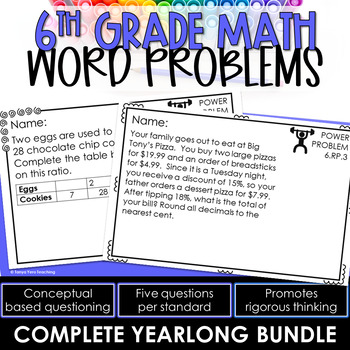6th Grade Math Word Problems | Math Spiral Review | Math Test Prep YEARLONG
- Zip
What educators are saying
Description
This set of 6th grade math word problems contains 5 questions for each math standard. The questions are designed to help build conceptual understanding.
These questions can be used for whole class lesson starters, 6th grade math small groups, rotations, homework, math spiral review and math test prep.
Math word problems help students take math understanding to the next level. And these Power Problems were designed to do just that. Not all math word problems are created equally, it is important that word problems are realistic, relatable and written to promote higher order thinking. Power Problems do just that!
Combining a math word problem attack strategy with a good set of math word problems is a proven research-based strategy for deepening students’ mathematical understanding.
You can confidently use these word problems knowing that the questioning is targeting conceptual understanding. Students will need to use their reading and comprehension skills while also applying everything they have learned in math class.
Mastering the art of solving math word problems takes a lot of practice. With five questions for each standard, this set of Power Problems includes plenty of opportunities for practice.
How Power Problems will help your students:
- Display Math Applications in the Real World: Power Problems will show students how math concepts apply to real world situations and why math is so important.
- Develop Critical Thinking Skills: Some basic reasoning and elimination skills can lead to success with multiple choice questioning, but these word problems will require students to read carefully, gather relevant information, solve the math problem and think about whether or not their answer makes sense in the context of the problem.
- Application of Multiple Concepts: Power Problems will require students to pull apart problems, solve multiple pieces, put them back together into a logical solution.
- Build Creativity: Procedural math questions don’t build a great deal of creativity. In fact, with enough procedural questioning, students will just memorize the answers. But with Power Problems, there will be opportunities for students to create their own equation to solve the problem leading to several different approaches.
- Teacher Screening Aid: The best screeners of students are good teachers! And Power Problems are a great tool for teachers to visually see the mastery level of each of their students for each math standard or concept.
We have Power Problems for grades K-8! CLICK HERE to shop!
Standards & Topics Covered:
Ratios and Proportional Relationships
- 6.RP.1 – Understanding ratios
- 6.RP.2 –Understanding unit rates associated with a ratio
- 6.RP.3 – Use ratio and rate reasoning to solve real world problems
The Number System
- 6.NS.1 - Interpreting and commuting quotients of fractions
- 6.NS.2 – Fluently divide multi-digits numbers
- 6.NS.3 – Fluently add, subtract, multiply, and divide
- 6.NS.4 – Finding the greatest common factor of two numbers
- 6.NS.5 – Understanding positive and negative numbers
- 6.NS.6 – Understanding a rational number as a point on a number line
- 6.NS.7 – Ordering absolute value of rational numbers
- 6.NS.8 – Solve real world problems by graphing points on a coordinate plane
Expressions and Equations
- 6.EE.1 – Write and evaluate numerical expressions involving exponents
- 6.EE.2 – Write, read, and evaluate expressions using variables
- 6.EE.3 - Apply the properties of operations to generate equivalent expressions
- 6.EE.4 - Identify when two expressions are equivalent
- 6.EE.5 - Understand solving an equation or inequality as a process of answering a question
- 6.EE.6 - Use variables to represent numbers and write expressions when solving a real-world or mathematical problem
- 6.EE.7 - Solve real-world and mathematical problems by writing and solving equations
- 6.EE.8 – Writing inequalities
- 6.EE.9 – Using variables to represent two quantities in real world problems
Geometry
- 6.G.1 – Finding area of triangles
- 6.G.2 – Finding volume of prisms with fractional length amounts
- 6.G.3 – Drawing polygons on a coordinate plane
- 6.G.4 - Represent three-dimensional figures using nets made up of rectangles and triangles
Statistics and Probability
- 6.SP.1 – Recognize statistical questions
- 6.SP.2 - Understand that a set of data collected to answer a statistical question has a distribution
- 6.SP.3 – Measuring the center of data
- 6.SP.4 - Display numerical data in plots on a number line, including dot plots, histograms, and box plots
- 6.SP.5 – Summarize numerical data sets





